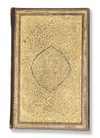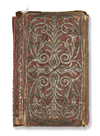Lot 90 AN ILLUMINATED OTTOMAN PRAYER BOOK, ANAM-I SHARIF, SIGNED BY SEYYID MUSTAFA ZIHNI EFENDI, TURKEY MID-18TH CENTURY
Arabic manuscript on paper, each page with 15 lines written in black naskh script within gold and red rules, gold roundel verse markers outlined in black and pointed by polychrome dots, catchwords and important words in gold. Surah headings in white thuluth script on a gilt ground within a decorated panel. Two opening biofolia heavily with gilt and polychrome decoration framing 7 lines of black naskh script in clouds reserved against a sprinkled gold ground. Final three pages with completion of the recitation of the Qur'an (Dua-i hatm-i Qur'an) and signed by ''written by al-Faqir Seyyid Mustafa Zihnî''
brown morocco binding with gilt-stamped medallions, with flap and metal-thread-embroidered slip-case.
11 by 17 cm.
The Prayer Book This prayer book comprises selected verses from the Qur’an, including surah Al-Fatiha, Al-An‘am, Al-Dukhan, Al-Kawthar, Al-Fath, Al-Rahman, Al-Mulk, Al-Masad, Al-Ikhlas, Al-Falaq, and Al-Nas, followed by the Beautiful Names (Asma’ al-Husna) and an accompanying commentary (sharh).
It also contains: The Names of the Prophet with commentary, the Prayer of Forgiveness (Istighfar), the Prayer of the Lord of Forgiveness (Sayyid al-Istighfar) and its commentary, the Prayer of Faith and its commentary, the Prayer of the Greatest (Du‘a al-A‘zam), the Covenant Prayer (Du‘a al-‘Ahd), the Prayer of Light (Du‘a al-Nur) and its commentary, the Goblet Prayer (Du‘a al-Kadah), Qasida al-Burda, the Names of the Companions of the Battle of Badr, A Munajat (Prayer of Supplication), the names of the Prophet’s companions, listed in alphabetical order.
It also features two illuminated pages bearing the names “Allah” and “Muhammad” set against a gold-sprinkled ground; the Hilya of the Prophet, the four Caliphs, Hasan, and Husayn; the genealogical tree of the Prophet featuring the Asharat al-Mubashsharun; the family tree of Ahl al-Bayt; depictions of the Prophet’s flags and the sword of ‘Ali; the Seal of Prophethood (Muhr al-Nubuwwah); the Seals of Solomon and Ja‘far al-Sadiq (preceded by commentary); the Rose of the Prophet Muhammad; the Rose of ‘Ali ibn Abi Talib and Fatima; and the Companions of the Cave.
Colophon and Attribution: Beneath the colophon on the final folio, which records the name of the calligrapher, a small cartouche identifies the illuminator as “‘Ali, the illuminator of the Private Library of the Interior Palace (Kitābhāne-i Khāṣṣa-yi Enderūn-i Ḥumāyūn).” The illumination of the manuscript’s frontispiece bears a striking resemblance to that of a Qur’an executed by Mehmed Nuri Efendi in 1748 AD. Both works feature a harmonious blend of stylised vegetal motifs and naturalistic floral elements in the side panels (see M. Uğur Derman, Ninety-Nine Qur’an Manuscripts from Istanbul, Istanbul, 2010, pp. 250–253).









